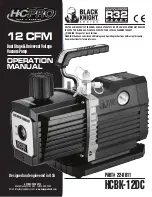
Installation
5
B. Reconnect power supply to pump and pump
up pressure in system.
C. Disconnect power supply to pump again and
re-check switch setting.
D. Repeat until pressure switch starts pump
within ±1 PSI of proper setting.
E. If cut-in setting is too low, system will rattle
or develop water hammer when pump starts.
F. Cut-out setting is not as critical as cut-in set-
ting. Make sure that pump will stop running
in a reasonable time. If it does not, cut-out
setting may need to be adjusted down slight-
ly. Be sure that after readjustment, system
does not rattle or hammer on startup.
7. Re-check tank air pre-charge to be sure it is 2
PSI below pump pressure switch cut-in setting
(see Page 3).
TESTING FOR WATER CELL
LEAKAGE
1.
Disconnect power to pump.
2. Drain all water from tank water cell by opening
faucet closest to tank.
3. Remove valve cap from valve and release all
pressure possible by depressing valve core.
When air stops coming from valve, remove
valve core to release remaining pressure.
4. Disconnect piping from elbow on tank flange.
5. Carefully turn tank upside down or lay it on its
side.
Retained water in tank may
cause sudden weight shift when lowering.
Support tank so that it cannot fall when being
lowered or inverted.
6. If water cell leaks, water will run out of valve. If
so, replace water cell.
WATER CELL REPLACEMENT
To be sure cover flange cannot blow
off of tank, release all air from system before re-
moving nuts from cover flange.
1. Disconnect power to pump.
2. Follow steps 2 through 5 under “Testing For
Water Cell Leakage”, above.
3. Remove nuts from tank cover flange. Tap cover
flange to break seal and remove.
4. Water cell will not come out in one piece. Hold
water cell with pliers and cut wherever conve-
nient with single edge razor blade or sharp
knife. Continue holding and cutting until water
cell is removed.
5. Clean and dry inside of tank.
6. Before water cell can be inserted into tank, it
must be tightly rolled up as follows:
A. Place water cell on clean surface with open-
ing to one end and flatten to force air out.
Pull ends out flat (see Figure 3).
B. To get tightest possible wrap, start on one
side at top and TIGHTLY roll water cell diag-
onally to other side (see Figure 4). To force
out as much air as possible, be sure to roll
toward water cell neck opening.
7. To help insert water cell, sprinkle outside of it
with talcum powder. With tank on its side, push
tightly rolled water cell into tank, hooking water
cell neck ring over edge of tank head.
8. Insert arm in water cell and push sidewalls out-
ward. It is not necessary to remove all wrinkles
from water cell.
NOTICE:
Don’t push water cell into tank further
than its own length. In a large tank, water cell
can slip out of reach if pushed too far.
9. Clean tank head sealing surface and lip ring
groove of cover flange.
10. Pull lip ring of water cell through tank opening
and seat it against tank head.
11. Clean sealing surface and groove of cover
flange; place on tank (see Figure 5).
Figure 3 – Force all air out of water cell
Figure 4 – Roll diagonally toward neck
Figure 5 – Proper installation and
seating
Water
Cell
Tank
Wall
Cover
Flange
2822 0 9
2846 0597
2847 0597
Pull ends out flat
Roll Diagonally






































